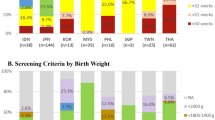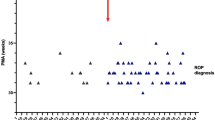Abstract
Objective
To detect the screening efficiency of general ophthalmologists (ophthalmic residents) as well as nonophthalmologists (pediatric residents and nurses posted in neonatal intensive care unit) in screening (ROP) retinopathy of prematurity on the basis of posterior pole vascular changes.
Methods
Prospective consecutive review in a tertiary care hospital setting. Five groups (each, comprising of one ophthalmic resident, one pediatric resident and a nurse) examined the posterior pole vessels of 200 eyes of ROP with a direct ophthalmoscope and compared with an ROP specialist using indirect ophthalmoscope. SPSS (Statistical Package for the Social Science), version 10.0 was used for the analysis.
Results
Results
Ophthalmic residents findings were: (sensitivity 95.68%, specificity 92.85%, positive predictive value 94.81%, negative predictive value 93.97%; pediatric residents findings were: (sensitivity 92.24%, specificity 88.09%, positive predictive value 91.45%, negative predictive value 89.15%); and nurses, finding were: (sensitivity 88.79%, specificity 85.71%, positive predictive value 89.56%, and negative predictive value 84.70%). The results had no statistically significant difference in diagnostic reliability. Kappa agreement analysis was significant for ophthalmic residents (0.887), pediatric residents (0.805) and nurses (0.744) compared with the ROP specialist. None of the children diagnosed with pre-threshold or threshold ROP was thought to have normal posterior pole vessels by the trainees.
Conclusions
Given adequate training, general ophthalmologists and non-ophthalmologists (pediatricians and nurse practitioners) are independently reliable in detecting posterior pole changes in ROP babies using direct ophthalmoscope and can be provided with a screening protocol.
Similar content being viewed by others
References
Bremer, Fellows RRet al. Strabismus in premature infants in the first year of life.Arch Ophthalmol 1998; 116: 329–333.
Cryotherapy for retinopathy of prematurity cooperative group. Multicenter trial of cryotherapy for retinopathy of prematurity: snellen activity and structural outcome at five and a half years.Arch Ophthalmol 1996; 114: 417–424.
O’Keefe M, O’Reilly J, Lanigan B. Longer term visual outcome of eyes with retinopathy of prematurity treated with cryotherapy or diode laser.Br J Ophthalmol 1998; 82: 1246–1248.
Larsson E, Holmstrom G. Screening for retinopathy of prematurity: evaluation and modification of guidelines.Br J Ophthalmol 2002; 86: 1399–1402.
Harrison RJ, Wild JM, Hobky. Referral patterns to an ophthalmic outpatient clinic by general practitioners and ophthalmic opticians and the role of these professionals in screening for ocular disease.BMJ 1957; 297: 1102–1107.
Andruscavage L, Weissgold DJ. Screening for retinopathy of prematurity.Br J Ophthalmol 2002; 86: 1127–1130.
Schwartz SD, Harrison SA, Ferrone PJ, Trese MT. Telemedical evaluation and management of retinopathy of prematurity using a fiberoptic digital fundus camera.Ophthalmology 2000; 107: 25–28.
Dhillon B, Wright E, Fleck BW. Screening for retinopathy of prematurity: are a lid speculum and scleral indentation necessary?J Pediatr Ophthalmol Strabismus 1993; 30: 377–381.
Saunders RA, Bluestein EC, Sinatra RB, Wilson ME, O’Neil JW, Rust PF. The predictive value of posterior pole vessels in retinopathy of prematurity.J Pediatr Ophthalmol Strabismus 1995; 32: 82–85.
Saunders RA, Margaret LD, Berland JE, Roberts EL, Powers BV, Rust PF. Non-ophthalmologist screening for retinopathy of prematurity.Br J Ophthalmol 2000; 84: 130–134.
Saunders RA, Berland JE, Bluestein EC, Donahue ML, Wilson ME, Rust PF. Can non-ophthalmologists screen for retinopathy of prematurity?J Pediatr Ophthalmol Strabismus 1995; 32: 302–304.
Harper R, Reeves B. The sensitivity and specificity of direct ophthalmoscopic optic disc assessment in screening for glaucoma: a multivariate analysis.Graefes Arch Clin Exp Ophthalmol 2000; 238 (12): 949–955.
Faigen M. The early detection of glaucoma in general practice.Aust Fam Physician 2000; 29(3): 282–285.
Author information
Authors and Affiliations
Corresponding author
Rights and permissions
About this article
Cite this article
Azad, R.V., Manjunatha, N.P., Pal, N. et al. Retinopathy of prematurity screening by non-retinologists. Indian J Pediatr 73, 515–518 (2006). https://doi.org/10.1007/BF02759897
Issue Date:
DOI: https://doi.org/10.1007/BF02759897




